AT 105 GNK Saxon
 United Kingdom (1982)
United Kingdom (1982)Armoured Personal Carrier, Wheeled - 1200+ total (as of 1995).
Development
About GNK Sankey
The British firm GNK Sankey went back to 1749 ('Dowlais Ironworks') and became after a 1900 fusion Guest, Keen & Co. Ltd and then Guest, Keen and Nettlefolds (GKN), working for the automotive industry and producing industrial goods and parts in general for several sectors with Steel production staying at its core. After WW2 it became Guest Keen Iron and Steel Co. from 1954, specializing in Fasteners, Crankshafts, and Pressed steel wheels for practically all British automotive manufacturers. In between in 1951, the postwar government nationalised the steel industry under Iron and Steel Corporation of Great Britain.
GNK Steel from 1969 consolidated its vertical and horizontal position in the steel industry by acquiring Miles Druce and Co in 1974, and started working for the army. It became eventually the developer and even producer of the British FV432 APC in one of its branch, and producer of the Humber Pig armored hull.
At the start of the seventies, GKN Sankey worked on its own funds, as a private venture, on the AT 100 4x2 vehicle for police duty. It never went into production, but the prototype had some promising caracteristics. The choice of a 4x2 was driven by the need they imagine of an ucoming order for a new vehicle to be deployed during the troubles in Northern Ireland. The new vehicle needed to be well-armored but not armed and used as internal security vehicle in an urban environment, so the off-road caracteristics were secondary. The AT 100 was completed in 1971 but failed to attract any interest, even from Sankey itself. It was asymetrical, with the engine one one side and the driver's cab on the other and perhaps its ungainly appearance counted for its rejection.
The GNK AT 104

Depiction of the AT 104 by Yuvnashva Sharma.
The AT104 was essentially a revised and 4x4 version of the AT 100, designed for the same purpose, public order maintenance. As an internal security vehicle it garnered interest at least of the Netherlands this time, only 28 vehicles sold to the De rijkspolitie, the Dutch State Police and the Royal Brunel Malay Regiment. This lackluster result was due notably to the short period during which it was offered of three years (1972-1975) with still little interest by GNK to correctly market it.
The vehicle was quite different to the AT 100, still with a functional but ingainly appearance, but a centrally-mounted engine, large sides mudguards, a commander’s cupola in the centre with a single piece hatch cover folding forwards, four bullet-proof vision blocks. A small turret was also proposed as an option with three vision blocks, one periscope, but never adopted. Armament stayed relatively light albeit many fittings were proposed. The pintle-mounted machine gun was nevertheless standard on final production vehicles.
Nevertheless, now the vehicle at least put GNK on the map for standalone military vehicle rather than simple supplier. Eventually it's not to deal with the Irish population the vehicle would make a rebirth, but the needs of the British army of the Rhine (BAOR).
A new vehicle for BAOR
The GKN Sankey AT105, later called the Saxon, was a completely new vehicle which only shared with the AT 104 identical parts liked to the Bedford RL 4x4 four ton truck chassis. It was the standard vehicle of its category used by the British Army and well exported. Studies started early on, in 1976. At first the British Army bought three vehicles for testing, while 200 has been already exported to Barheim, Kuwait, Malaysia and Oman.In 1984 the army placed an order for fifty vehicles. The first were delivered later that year, intended for the British infantry battalions scheduled to join the BAOR in wartime, sent in West Germany. These battalions used until then the standard, unarmored Bedford Mk 4x4 truck, so having a fully armored version was immediately seen favourably due to the relatively low cost of the vehicles. The British Army's request was ramped-up soon to a thousand vehicles to be be assigned to Territorial Battalions, and Regular Battalions alike. Soon named the "Saxon", the was delivered in large numbers until 1989 by GNK Sankey.
Design
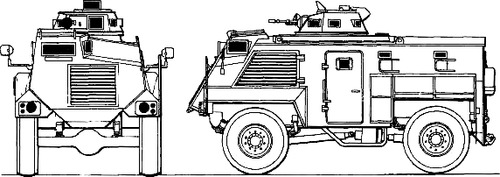
The Saxon was basically a cheap and efficient "battle-taxi" with enough comfort to make long journeys in the cold German weather, more bearable for British Army of the Rhine. What attracted interest from the Army was its relatively low cost indeed, even for an armoured personnel carrier. Like the previous bedford Pig, the AT 105 was based on a revised Bedford M series 4x4 truck chassis. The latter was a very common army truck, widely exported, trusted, with an already low chassis cost. In addition it used mostly commercially available components.
Despite a bulky, intimidating appearance, this was a still lightly armoured wheeled vehicle, making it faster on roads and easier to maintain compared to tracked vehicles. A considerable change compared to the M113 and the vehicles it was to replace from mid-1985: The Saracen and Humber "Pig", its predecessor.
Hull & Armor
The AT105 hull was monocoque, using the chassis and as many components of the Bedford TM 8-Ton Truck as possible. The hull is quite tall and rectangular, with the driver located at the front right of the hull, with a large window in the front, smaller ones on the left and right. A large horizontally ridged grille is placed at the front, bottom left. On each side mid-lenght is placed a large rectangular door, with a window. Just behind, two windows provided with firing hatch below are located insted of pistol port to fire on the march.he vehicle is armoured against small-arms fire (armor thickness around 8 mm) shell splinters, but not intended withstand dedicated AT weapons or even light guns, but as proof against heavy MGs like the Russian KPVT and DSHK. It was 6 to 12.5 mm thick and according to Dutch sources, up to 16/17 mm, so even greater for the sloped parts.
As defined as a troop trasnsport, it was to be armed with a single machine gun for close defence. Its hull was made of welded steel, but with a V-shaped underbelly plate. It is a important addition to deflect mine detonations, inspired by South African vehicles. But this made the vehicle taller and this a bit more unstable. Seating in the rear compartment comprised two banks for five seats, enough for ten troops, and eight with all equipment included. Still, the vehicle was provided with an equipment stowage area on the hull roof.
Engine
The engine hood was separated from the driver's cabin, on the right side. It cntained behind the armoured louvres in front of the radiator, a Bedford 500 6-cyl diesel rated for 164 hp (122 kW). It allowed for a range of 510 km (320 mi) and a maximum speed of 96 km/h (60 mph), not bad given its 11.660 kg weight. Also, it had limited cross country mobility, but still was capable of operating in forward areas. it as found able to climb a gradient of 60%, a side slope of 30%, a vertical step of 0.45 m, gap a trench of 0.5 m and fording 1 m without preparations.Armament
A standard NATO 7.62 mm GMPG light machine gun is mounted in a small turret, with slab-sided walls and windows, at the front center, on the roof. A small periscope is placed on its left and right, and a larger one at the front to fire without opening the single piece hatch above. The mortar variant was prsented with the rear compartment topped by two large hatches to be opened when firing, and the compartment housing a foldable standard NATO Brandt 81 mm mortar. The commander has a fixed cupola with a ringfo the 7.62 mm machine gun, on an unprotected pintle.Variants
-Saxon IS ("Saxon Patrol") was a batch of vehicles acquired for service in Northern Ireland. They were used as ambulances or troop carriers with extensible wings used as protective shields during a riot, very much like the Humber Pig ("flying saxon"). Compared to the standard, various minor modifications were added specifically tailored for internal security operations: Searchlights, wire cutters and bull-bar to remove barricades, full interior makeover and new spaced-armor, more powerful Cummins 160hp turbo-diesel engine, mesh covers on the windows.-Ambulance (AT105A, with stretchers at the back for up to eight patients.)
-AT105E Turret vehicle (armed with one or two machine guns).
-Command Vehicle AT105C (Royal Artillery air defense regiments).
-Mortar Carrier AT105MR, see notes in armament. Single 81 mm mortar.
-Recovery Vehicle Saxon ARV (side-mounted winch).
All were presented but little informations is available. Only the large use of the Ambulance in Northern ireland is attested and possibly the others exported only.
Users and Service
The first operational Saxons were deployed in Germany in 1983. They were assigned to mechanised infantry battalions. It was withdrawn from service but 147 are allegedly kept in storage accoridng to some sources. The vehicles exported are still deployed, or were so, Bahrain, Brunei, Bosnia, Malaysia, Oman, Iraq and Afghanistan for crows control, police and second line army units deployed in patrols. They were deployed by the IFOR and other late 1980s and early 1990s peace operations.Seven Saxons were ordered by the Royal Hong Kong Police back in 1987, delivered in 1988, replacing the old 15 Saracens and assigned to the Police Tactical Unit. They were ultimately withdrawn in 2008-2009. Those storaged were refurbished and resold to ukraine at a low price.
75 Saxons were sold to Ukraine under a 2013 contract, before the start of the War in Donbass. The Ukraine military announced the signature only on 5 December 2014. But this was heavily criticized by General Sir Richard Dannatt, saying this sell was "immoral" as the vehicles for him were "useless" in the type of high intensity combat. Nor records exist however for their eventual losses in combat.
Exports, current users: Bahrain, Congo (28 in 2015), Ivory coast (4 second-hand delivered 2016 MINUSMA), Djibouti: (4), Iraqi Armed Forces and police, Jordan: 12 second-hand vehicles delivered and modernized by KADDB (left steering, newer engines, gearbox, prototype shown at SOFEX 2010); Malaysia (Malaysian Police), Mauritania (4 second-hand delivered 2016 via France for UN ops in Central African Republic), Mozambique (25 delivered 2013), Nigeria, Oman, Somalia (50 donated by Djibouti April 2013), Ukraine (75 second-hand vehicles), Serbia (Serbian Gandarmery, seized from UN peacekeepers in Bosnia-Herzegovina war).
Read more/Src
About the GNK AT 104On warwheels.com
On armyrecognition.com
"British Army Vehicles In Ulster" (January 1996 Issue of Military In Scale Magazine), Bob Morrison
"Desert Insurgency" (December 2013 Issue of Military Machines International Magazine), Carl Schulze
"Flying Saxon" (December 2012 Issue of Military Machines International Magazine), Ian Young
ISAF Vehicles in Afghanistan: 2007 (Kabul and Kandahar Areas) - Mushroom Model Publications, Patrick Keenan, Dick Taylor
Jane's Tank Recognition Guide (4), Christopher F. Foss
"On Patrol: Part 2" (April 2008), Geoff Fletcher
"Royal Malaysian Police" (September 2008, Military Machines International Magazine), Ian Stroud
"The Saxon in British Army Service" (Nov 2002 Military Machines International Magazine)
Wheeled Armoured Fighting Vehicles In Service, B.T. White
Bedford RL Armoured Truck specs* | |
| Dimensions | 5.17 x 2.49 x 2.63 m (17 x 8.2 x 8.8 in) |
| Total weight, battle ready | circa 10.6 tons (30,000 ibs) |
| Crew | 2+10 (Driver, co-driver, 10 infantry) |
| Propulsion | Bedford Bedford 500 6-cyl diesel 164 hp (122 kW) |
| Suspension | 4x4 leaf spring |
| Speed (road) | 96 kph (60 mph) |
| Range | 510 km (320 miles) |
| Armament | 7.62 m GMPG, infantry weapons |
| Armor | 7-12 mm front and sides (0.28-0.5 in) |
| Total production | Circa 1200, 1983-1989? |
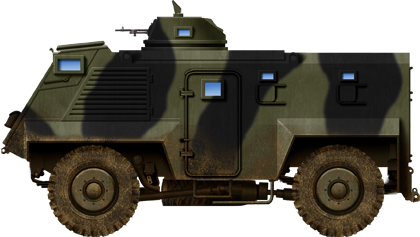
Basic Saxon in initial configuration, British Army.
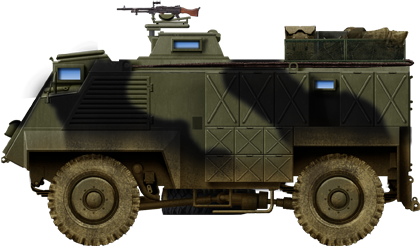
BAOR Saxon in the 1980s with additional side storage boxes and modified turret.
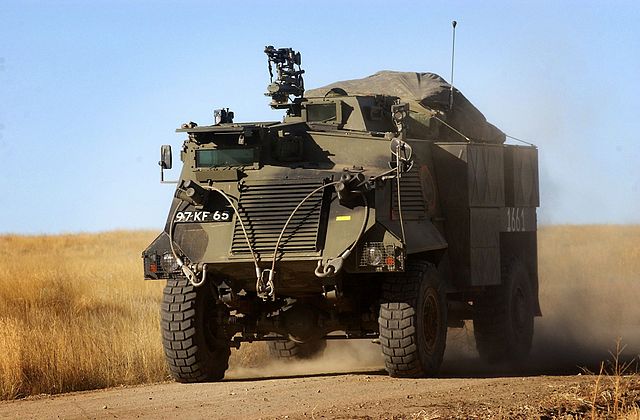
Saxon_Cheshire-Rgt-1stMechanised-Brigade-3-canada2003
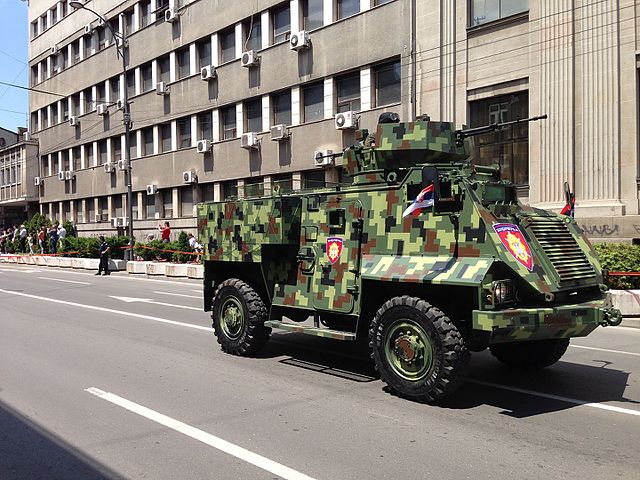
Police_Day_2017-serbian-gendarmerie-saxon.
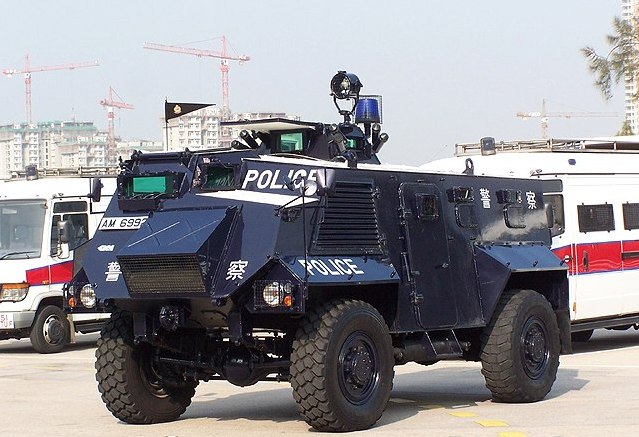
Saxon_Police_HK.
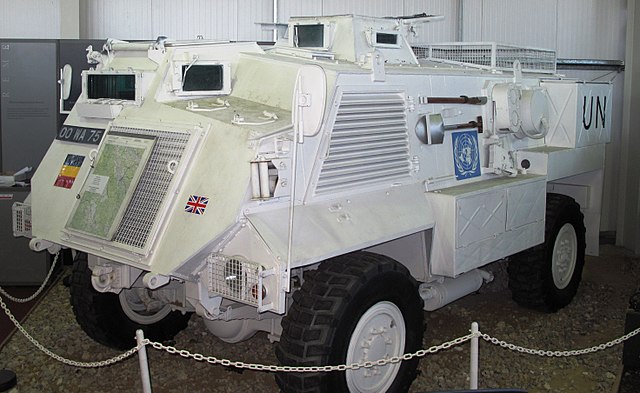
Saxon_UN-Recovery_Version-REME-museum.
saxon-AMISOM_Djiboutian_Contingent_Belet_Weyne.

Cold War Tanks


































Cold war tanks posters

Cold War Main Battle Tanks

Cold War Soviet Army
Museums, Movies, Books & Games
The Tanks and Armor in pop culture
Tanks and armored vehicles in general are only really grasped when seen first person: The mass, the scale, it's all there. Explore also the way tanks were covered in the movie industry, in books and in video games.Movies:
Best tanks movie on warhistoryonline.com
On imdb.com
On bestsimilar.com/
miltours.com
liveabout.com/
watchmojo.com
Video Games:
pcgamesn.com
historyhit.com
levvvel.com
vg247.com/best-tank-games
mmobomb.com/
alienwarearena.com
